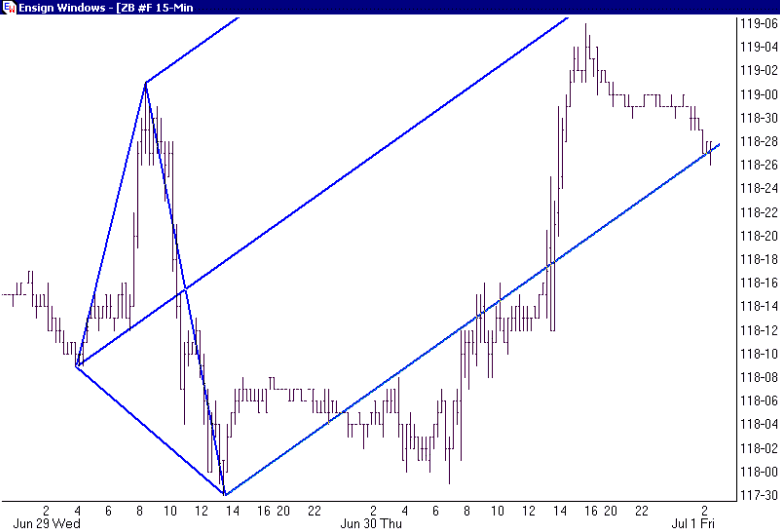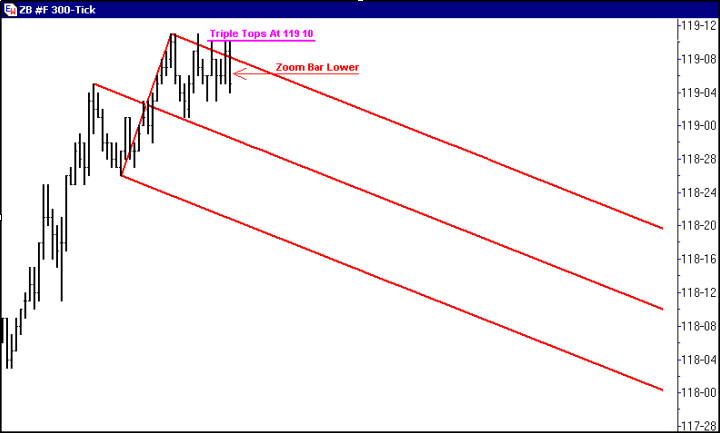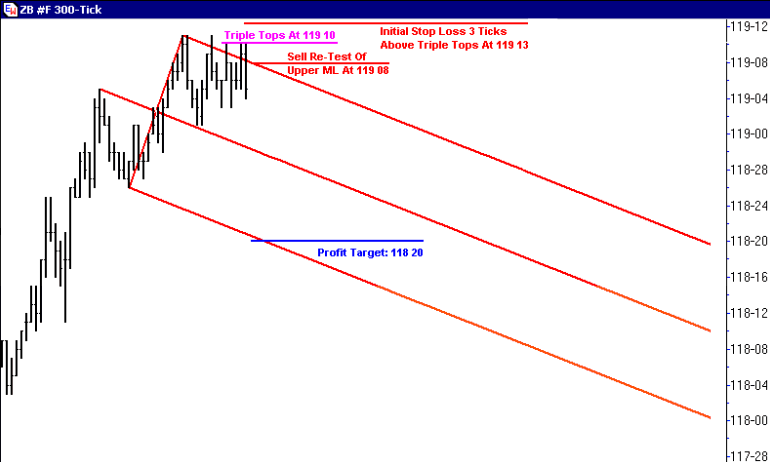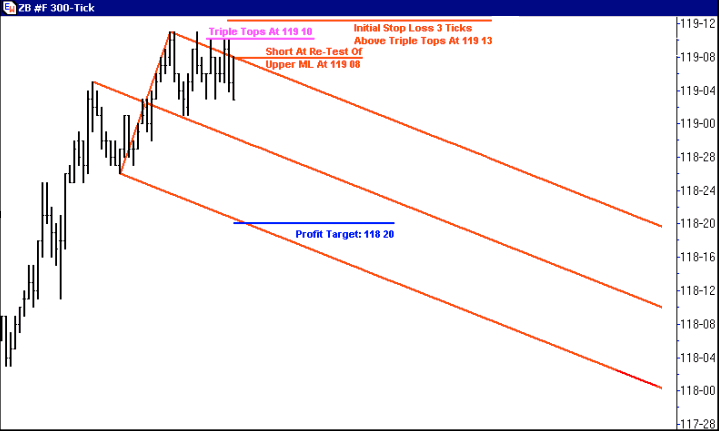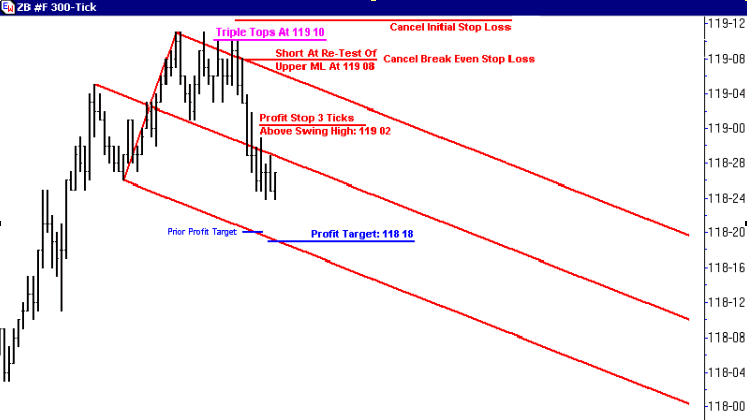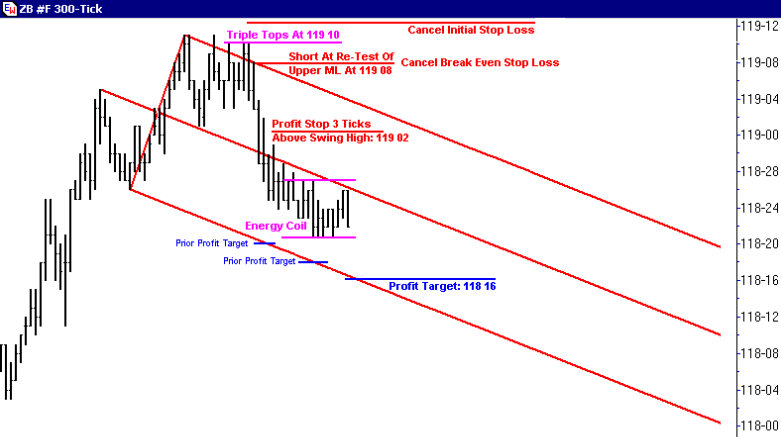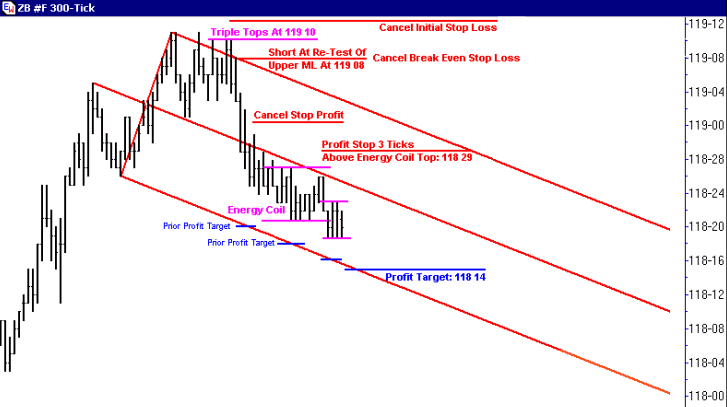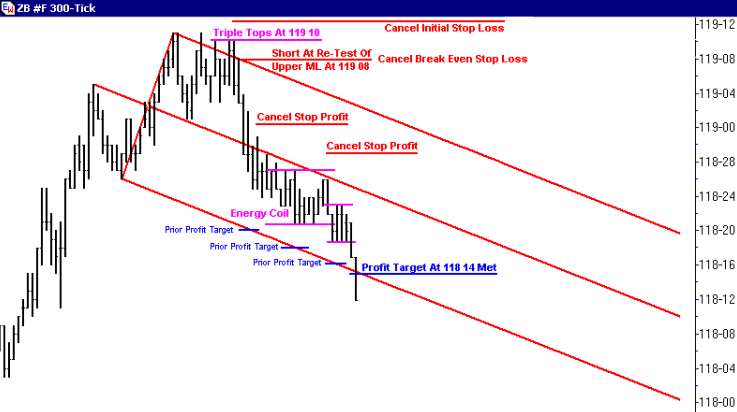by Timothy Morge Letís look at an actual trade in the 30-Year U.S. Bond futures. This is my favorite interest rate future to trade, because you get the most "bang for the buck" and if you are a bit crafty, thereís still plenty of movement to day-trade them, off-floor, if thatís your trading style. One of the problems off-floor traders find with all of the interest rate products is that they have several sharp moves. But between those sharp moves, there are long periods of inactivityósome traders call this "flat lining". This "flat lining" tends to deform or diminish the effectiveness of trading methods, because time continues to pass while the contract stops moving. When using Median Lines, I say that price "drifted out" out the Median Lines because time has moved to the right [or marched on] while price has stayed still. Is there a way to address this drifting and thus make these contracts more tradable? Actually, there are several ways to address the "drifting effect" and Iíll show you today one of these ways, in detail, and how to combine it with Median Lines to trade these markets effectively. The oldest and most well known method is point and figure charting, and you could use this method, along with Median Lines, to trade these contracts. But I donít find the combination of Point and Figure Charts and Median Lines to be a good combination. Instead, I like to use "tick based" bar charts, where each bar on the chart shows X amount of ticks of trading activity. So if I choose to look at 300 tick bars, each bar on the chart will show 300 ticks of activity and the range, open, high, low and close that happened while those 300 ticks unfolded. Once 300 ticks have been reached, a new bar is started. By choosing to look at tick based bars, I have taken time out of the equation, which "can" be a good thing. In this case, it is a positive, because it generally eliminates the drifting effect I just mentioned, and that makes the Median Lines much more effective in showing me where price is liable to run out of energy, and where price is likely to find support and resistance. Letís compare a time based bar chart and a tick based bar chart:
This is a 15 minute time based bar chart. Note how price tends to stall, dead in the water, at times. This causes price to "drift" through the right" of any Median Line you draw, reducing their effectiveness. Now lets compare this time based chart with a tick based chart, of the same time period:
Note here how the "dead periods" have literally disappeared from the chart, although it is a chart of the same "time frame." Because the bars are based on numbers of ticks, these dead periods are hidden within the tick bars. Now letís look at a few actual trades, in a step by step manner, and see how to trade using tick bars and Median Lines:
Example 1: Price has made a nice run up but it has now re-tested its highs once and when it failed to make a new high, it traded a bit lower and then left triple tops in place at 119-10, below the swing highs of the move. You can see that I added a red down sloping Median Line set, drawn from the prior three alternating pivots. Now note that the last bar on this chart, the last of the three triple tops, "zooms" or runs back lower through the Upper Median Line Parallel after trying to get and hold above it. And note that price closes in the lower third of this "zoom" bar. We say this bar closed with "good separation," which is an indication of the selling pressure or momentum it had to the down side, once it failed to hold above the Upper Median Line Parallel. The quality of the separation found in a zoom bar gives us clues to its likely reliability. That means that if a bar zooms through a Median Line or one of its parallels but closes near or on the line it just zoomed, it had poor separation and is a poor example of a zoom bar, and thus, less likely to be reliable in a trade set up. Zoom bars can be used for high probability trade set ups, and thatís what weíll try to do in this first trade example. Letís see what I can diagram as a potential trade that makes sense and has a good risk reward ratio.
Because price closed with good separation and also left triple tops above the down sloping Upper Median Line Parallel, I want to be a seller of this market IF price gives me a high probability trade entry with a solid risk reward ratio. Letís look at all of these things, one by one: By a high probability trade entry, I mean by looking at tens of thousands of actual trades I have made over the thirty plus years I have been trading, I am able to categorize each trade taken in the past according to the trade entry method associated with each trade and then do in-depth statistical analysis, telling me the probabilities of success of each of the trade entry set ups I use when trading. In this particular trade, I am looking to sell after a "zoom and re-test," which is a trade set up that I used thousands of times, so I know after a great deal of actual trades the probability of success of this trade is better than 70 percent. As I mentioned earlier, the quality of the separation in this zoom bar gives it a higher likelihood of success. Again, separation visually tells us about the quality of the selling or buying pressures associated with the bar. Better separation in the same direction as the contemplated entry shows a strong correlation with the probable success of the trade. Now the trade plan: I want to sell a re-test of the just-zoomed Upper Median Line Parallel at 119-08. My initial stop loss order will be at three ticks above the 119-10 triple tops, at 119-13. That means I am risking 5 ticks per contract, which is $31.25 per tick times 5, or $156.25. My profit target is a test of the Lower Median Line Parallel, which initially comes in at 118-20. That means that if I am correct, I expect to make 20 ticks, which is $625 per contract. This gives me a risk reward ratio of 20/5, which equals 4. I donít take trades that have a risk reward ratio of less than 2, so this trade set up is more than acceptable. And Iím certainly willing to risk $156,25 per contract on the initial stop loss. I like the look of this trade set up, as well as the probabilities associated with it. I enter a limit order to sell 30 year bond futures at 119 08/32, and I also enter a stop loss buy order at 119-13, so that I have limited my loss right from the beginning. Letís see if the market letís us get filled:
Price comes back up and re-tests the down sloping Upper Median Line, getting me short bond futures at 119-08 in the process. Remember from the Median Line theory that we expect price to run out of energy at or near the Median Line or its parallels, so it shouldnít be a surprise that price stopped going higher after testing the Upper Median Line ParallelóIn fact, thatís exactly what I was expecting and why my order was to get short at the re-test of the Upper Median Line Parallel. Once I get confirmation from the exchange that I am indeed short, I enter my profit target: I enter a limit order to buy bond futures at 118-20, and I make it "OCO" with my initial stop loss order at 119-13 ("OCO" means that once one of these two orders is filled, the remaining order is immediately cancelled). Note that price closed on its lows, something I like to see when short. This indicates that price likely still carries additional downside directional energy. Now that I am short, Iíll have to watch as price unfolds:
Price continues to sprint lower, again making a wide range lower bar that closes on its lows. And when price penetrates and closes below the down sloping Median Line, itís a sign that I should be evaluating my outstanding risk and if possible, reduce it by trying to move my stop loss closer to the current price action. But Iíll have to be careful! I want to move my stop closer if possible, but I need to stay far enough away that I donít find myself in the "noise" of this market and get stopped out right before the market resumes its downward move. Looking at the price action thatís unfolded since Iíve put the position on, Iím in a quandary: There have been only two price bars, both of them wide range bars with price closing near or on its lows. Because price has come straight down, there is no price context for me to use to hide my stops behind. What do I mean by that? I can use market formations like double tops or bottoms, trading ranges, swing highs or lows to hide behind when bringing my stops closer to the action, if they are available. As you can see in this example, there are no market formations [no context] to hide behind. The best I can do as this bar closes is cancel my initial stop loss order and put in a break even stop order at 119-08, meaning I am now risking nothing but brokerage on this trade.
Price makes another new low but then rebounds, climbing well back above the down sloping Median Line before falling all the way back down to close unchanged, below the Median Line. The next bar tests the Median Line again but then heads lower, making another new low and closing near its lows. The next bar opens unchanged, then leaves a double bottom before climbing up above the Median Line briefly, although it manages to close back below the Median Line. Note that we have now had four bars close below the Median Line. The next bar opens unchanged, below the Median Line, and makes a new low for the move, breaking through the double bottoms but climbing back up to close unchanged. I note with interest that the range of this bar is narrower than the bars I have been seeing. In general, as the ranges of the bars narrow, it is a sign that price may be running out of directional energy. It isnít a bad thing, but instead, it is a red light, telling me to be on the look out for further informationóand to be trying to reduce my risk when possible. I am tempted to move my stops closer, but I want to give price a bar or two more. The next bar opens unchanged again, then climbs back to test the Median Line, where it runs out of energy. And this bar closes on its lows. Finally, the last bar opens unchanged, trades lower, leaving a double bottom, but closes on its highs. And it is also the narrowest bar in this series of bars that form a range or "Energy Coil," which is an area where price is re-storing its expended directional energy. Two things prompt me to move my stop order closer: The narrowing ranges of the bars and the alternating closes at the extremes of the bars within the range. Both of these things reiterate to me that price is re-storing energy and that it is important that I have my stop orders as close to the action as possible without being within the "noise" of the market. I look at the chart and note the mini swing high price made when it briefly came back above the Median Line at 118-31. I then move my break even stop at 119-08 down to 119-02, three ticks above the mini swing high, making it a profit stop now. In essence, we are playing with the marketís money. I call this "boxing in profits" and our goal is to get to the point where we are playing with the marketís money as soon as possible, as long as we stay out of the "noise" of the market. I also re-calculated my profit target, by simply determining where price would intersect with the down sloping Lower Median Line Parallel. Because I am short against a down sloping line, as time goes by, my profit target moves lower, meaning I get paid more IF I am smart enough to keep adjusting my profit target. My new profit target is now at 118-18.
Now price forms a true energy coil, which runs for about sixteen bars. Even though price action has slowed down directionally, note that unlike traditional time-based bars, tick bars are still showing us price formations. While we are in this agonizing energy coil, Iíd love to move my stop profit order closer to the action, but I donít see any market formation or context YET that will allow me to do so without being too close to the noise of the market. Iíll just have to be patient until the market gives me more to work with. I AM able to move my profit target lower, however. I check where price will intersect with the Lower Median Line Parallel and then move it down to 118-16. Once again, I get paid for being short against a down sloping line as time goes on.
Price finally breaks below the current energy coil. Once the first bar closes below the energy coil, I move my stop profit order from 119-02 down to three ticks above the 118-26 top of the energy coil that price just broke out of, giving me a new stop profit order of 118-29. Again, I just keep boxing in profits as price approaches my profit target. As several more bars form, note that they are again narrow range bars. Iíve just moved my stop profit order as close as possible, so thereís nothing to be done there. But I measure where price will intersect with the Lower Median Line Parallel and note that its time again to move my profit order lower, because I am short against a down sloping line. I move my profit order down to 118-14.
Price breaks out of the narrow range [or the second energy coil] and closes on its lows. As I said earlier, bars of consequence that close on or near their extremes give an indication that price has further directional energy to spend in the same direction, and after spending that much time in energy coils re-storing energy, youíd expect that price had enough directional energy to quickly make it to my profit target. And indeed, it does during the next bar, punching through the Lower Median Line Parallel and filling my 118-14 profit order in the process. Once I get confirmation from the exchange that my profit order was filled, I make certain my stop profit order at 118-29 is cancelled and that I am working no further orders. This was a nice clean bond trade, netting me 26 ticks in the bond futures, which is $812.50 per contract. The important keys to this trade were 1) Picking a high probability trade set up that had a solid risk reward ratio associated with it; 2) Hiding stops behind market formations; 3) Boxing in profits while staying far enough away from the "noise" of the market; and 4) Remembering to monitor the profit target and move it accordingly as the bars unfold. Because I was short against a down sloping line, I got paid an extra 6 ticks to be short as time passed, because of the slope of the line. Timothy Morge is one of the most respected names in the futures industry today. Throughout his remarkable 30 year career Mr. Morge has been a floor trader on the CME, an institutional trader managing cash forex positions in excess of $2 Billion U.S. Dollars, the author of the highly acclaimed book "Trading With Median Lines," the owner of AutoForks software, a mentor and teacher to hundreds of professional traders, as well as the Managing Director of Spike Tradingís Proprietary Trading Group in Chicago. Mr. Morge regularly teaches "Market Maps" seminars to professional traders at the CBOT and the CME. These half day seminars focus on teaching the trading tools Morge uses in his own trading, as well as the money management and risk reward tools he has developed over his thirty year trading career. In February, Mr. Morge and Spike Trading will begin allowing non-professionals to take the Market Maps seminars in person or via the internet. Mr. Morge is giving a free CBOT webinar on Wednesday, Feb 15 at 10 am, and will use Ensign charts. The link to the registration for the Feb 15th event is: http://www.hotcomm.com/virmeetCID_ARR.asp?CID=YMDZYQ&MID=6B4WZD For further information on Market Map Seminars, go to: http://www.marketmaps.org AutoForks Software, which runs on Ensign, is at: http://www.marketgeometrics.com "Trading With Median Lines," written by Tim Morge, can be ordered at: http://www.medianlines.com/bookorder.html Hardware Tip: by Kimball Hansen, Ensign Software We have all heard about computer virus attacks and destructive web sites that destroy your computer data. There are other hazards such as fire, water damage, computer thefts, power surges, and faulty equipment that can cause your data to disappear. If you do not currently backup your computer files, then you are at risk of losing everything. Mike Lamont, at Ensign Software Support, often quotes the saying, "There are three types of computer users, 1) Those who donít backup their computer files, 2) Those who donít backup often enough, and 3) Those who donít check their backups." I guess a fourth type could be listed, 4) Those who backup on a regular basis, and check their backups, and keep them in a safe place. Which group do you belong to? The first group of users never backup their computer files. They hope that something bad will never happen to their computer. Perhaps they mistakenly believe that hard-disk crashes somehow involve an automobile. The truth is that they either need some education and training on how to backup (and why), or they just donít care enough about their computer files to learn how to backup and to take the time to do it. The users in the second group understand the importance of backing-up their important computer files, but they lack the motivation or discipline to backup on a regular basis. They have the ability to restore portions of their computer files (if their computer crashes), but the files are often old and out-of-date. The users in the third group are often very diligent at backing-up their data. However, they fail to verify that their backups are valid and useable. Or they fail to store their backups in a safe place. I have seen more than one user who was backing-up their data everyday, only to discover (after a computer crash) that their backup disks were bad, or the backup process was never set-up properly. They were going through the motions, but did not have a valid backup. Other users have experienced disasters, like a fire, that burned and destroyed their entire office. Both the computer and the backups were destroyed. Ouch! The users in the fourth group understand the possibility that their computer data could be lost at anytime. They have implemented backup procedures that protect their businesses and livelihoods. Their files are backed-up on a regular basis. The backup files are stored in a safe place (often off-site and sometimes in a fire-proof safe). Backup files are checked and verified. If a data loss ever occurs, these users can restore all of their files. This is the group that we should all belong to. Hopefully, you will never experience the agony of losing your computer files, or having your computer stolen. However, if you will diligently backup your computer files, then you can sleep well at night. If you want to be in the fourth group (the smart ones), then you need a couple of things.
A few examples:
Backup Software There are many different software programs that help you backup computer files. Some of them can be downloaded for FREE from the Internet. Some programs will automatically backup your files at a specified time of day. Search on ĎGoogleí for Backup Software and
you can read about dozens of programs. I happen to use a
free backup software package named ĎEZBack-it-upí. It
allows me to specify which folders and files on my computer
to backup. On subsequent backups, only the files that have
changed will be copied again. This is a time saver. The
software can either backup at a specified time, or whenever
I manually start the backup process. If you would like to
use ĎEZBack-it-upí you can download it from the following
web site:
Disclaimer: I am not saying that this is the best backup program in the world. However, it works fine for my needs. I could have spent a few hours and programmed my own backup software. But, why should I when there are free programs that already work fine. If your backup requirements are more complicated, you may need to purchase a program that has more sophisticated features. I will not give specific instructions on how to use backup software. Just realize that a useful program will allow you to easily select folders and files on your computer to backup. Note: Some of you may not require a backup program. If you know how to use the ĎWindows Explorerí program, you can drag and drop (copy) computer files and folders from your computer to a backup storage device. Backup Location or Storage Device The key to a successful backup strategy is to copy your important computer files to a different electronic storage device or location (as mentioned above). Then store the backup data in a safe location. I have a removable Hard Disk that is easily inserted and removed from my computer. This allows me to copy all of my important data to the removable Hard Disk. The removable Hard Disk is then stored in a small fire-proof safe in a hidden location (not easily found by a thief). The backup software is used to copy all the selected files to the removable Hard Disk. I run the backup software manually whenever I want to backup my data. This process is all fairly simple and provides a good level of backup security. I have another computer at different location. For that computer, I use 5 different Jump Drives for my backup needs. I wrote a small program that copies important file to the Jump Drive. I could use ĎWindows Explorerí if necessary to accomplish the same task. I use a different Jump Drive for each day of the week. On Friday, I do a more extensive backup and store that Jump Drive in a fire-proof safe. This gives me some incremental backup protection during the week, and a comprehensive and safer backup once per week. Jump Drives are very inexpensive and can hold from 128 megabytes up to 1 Gigabyte of data. They plug into a USB port and are very easy to use. Another idea: Many CD burning software programs allow you to select folders on your computer to backup to a CD. A typical CD-R will hold up to 700 megabytes of data. CDís are very cheap these days. This may be a good backup method for you based on your needs and computer. Summary If you have any valuable computer files, then you should have a regular backup process implemented. There are just too many ways that computer data can be damaged, stolen, or lost. Donít wait until you experience a hard-disk crash before joining the group of computer users who backup with diligence. Make sure that you check you backup data. Verify that it really contains the data that you intended to backup. Store your backup data in a safe location. If necessary, store the backup data at a completely different site. Developing a good backup procedure will help you to sleep better at night, and may completely save your business someday. Sweet dreams! |
